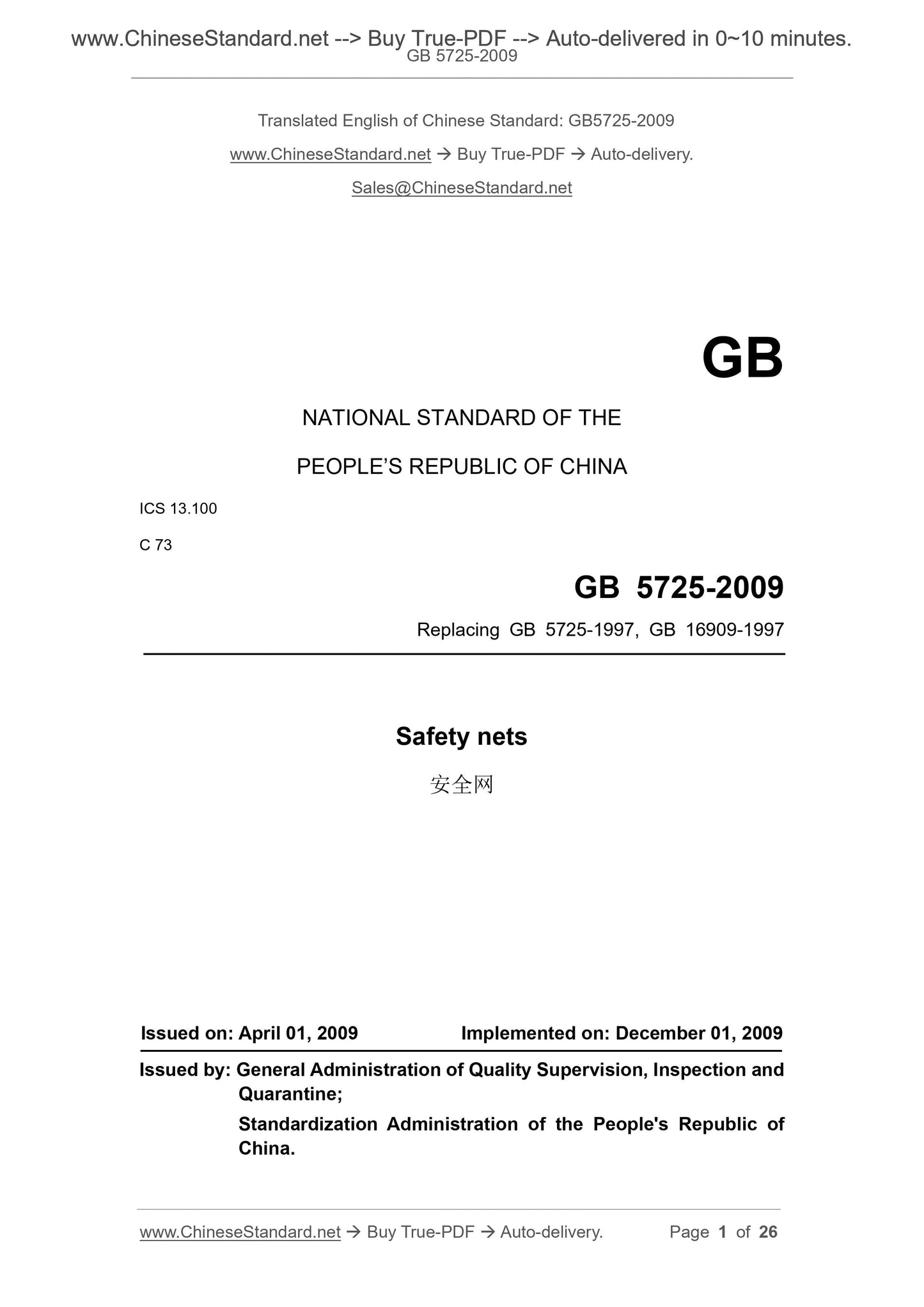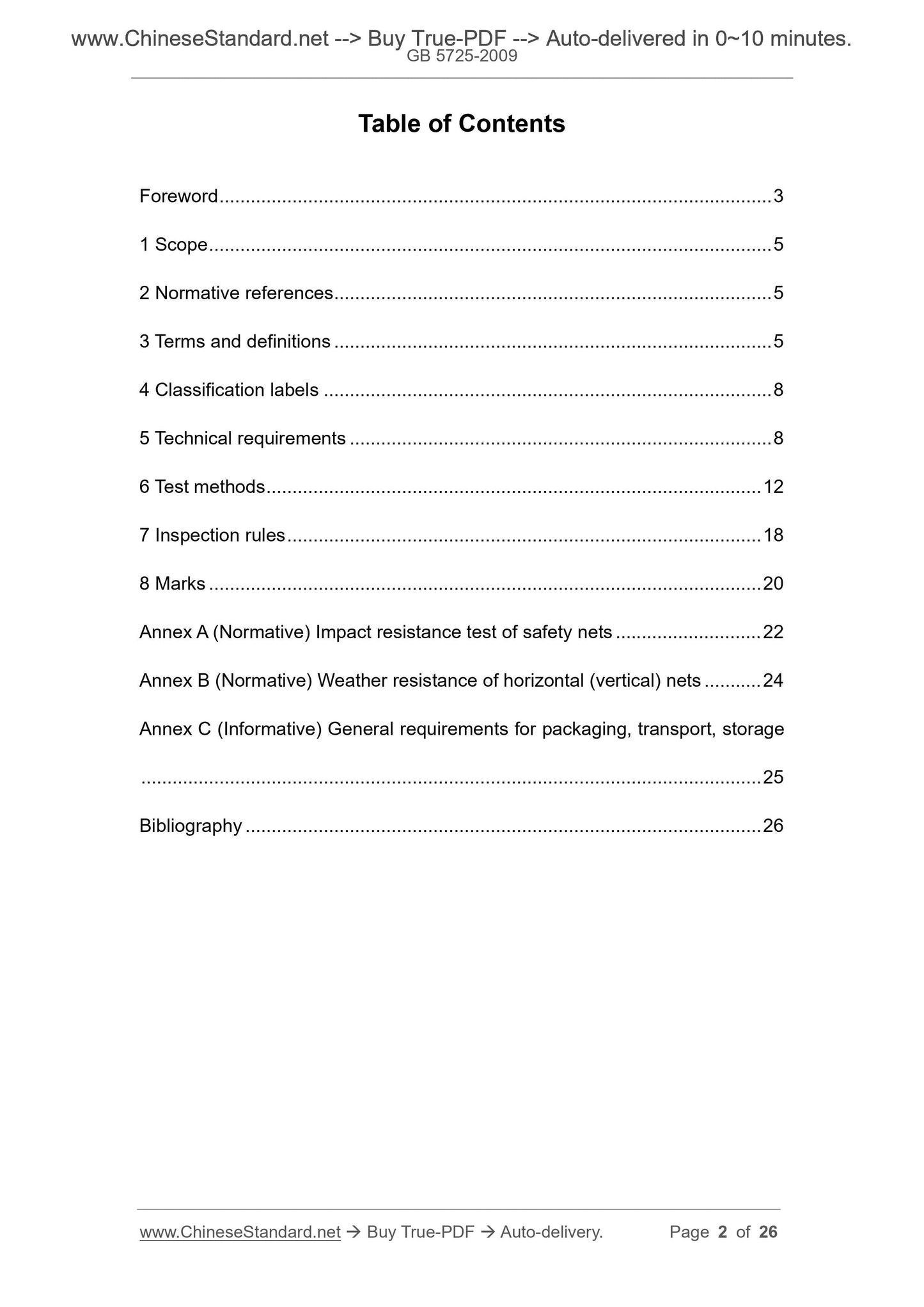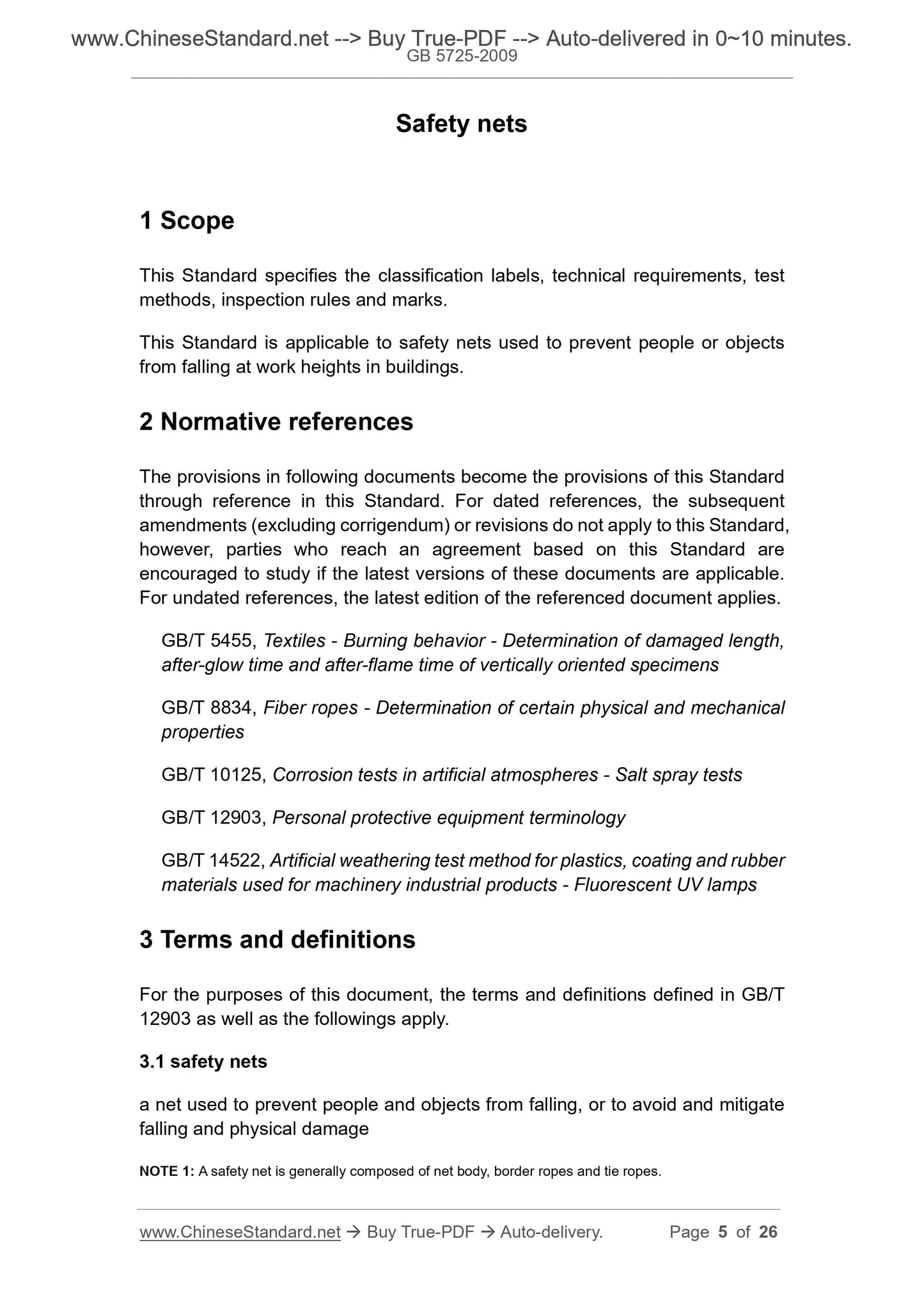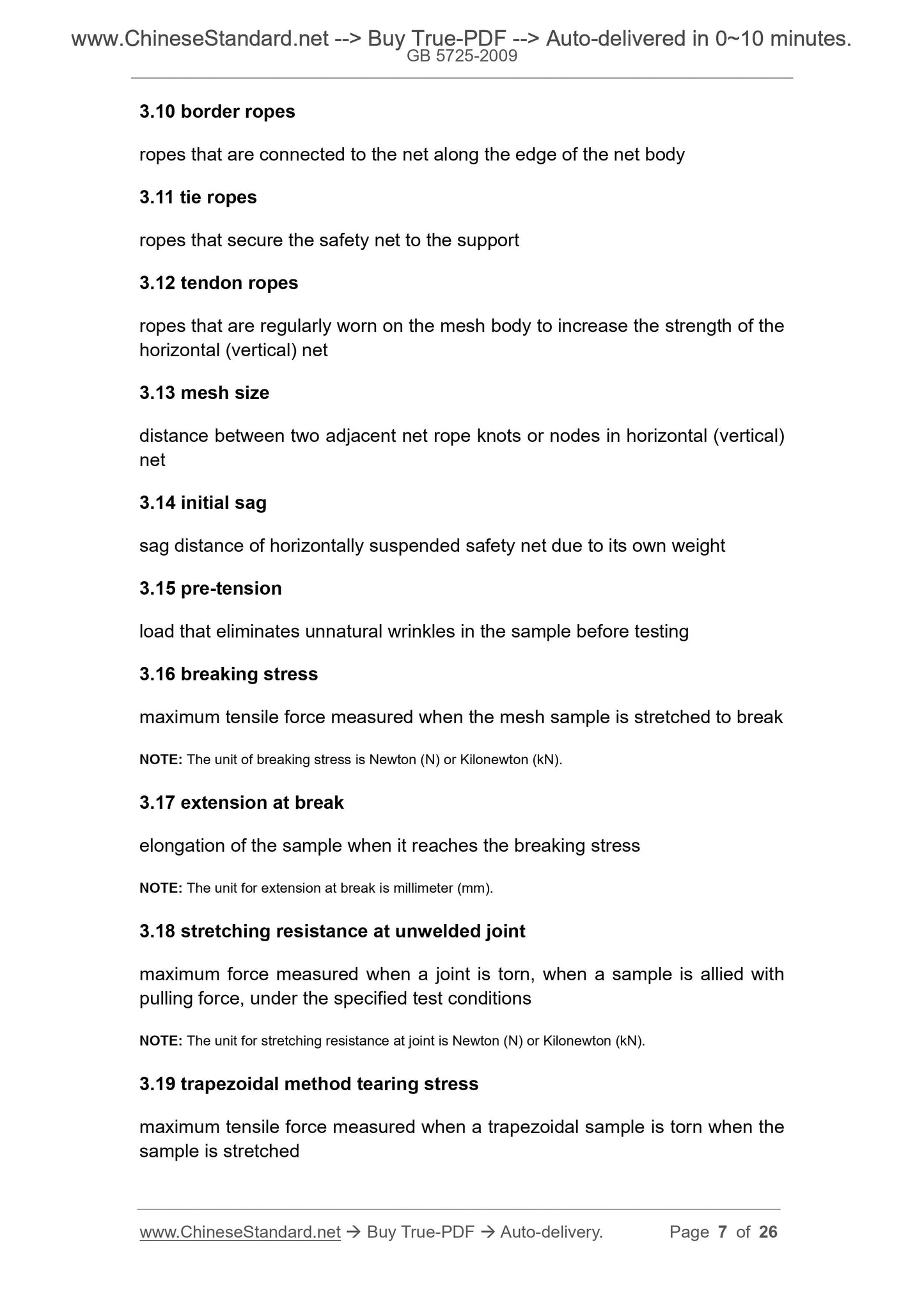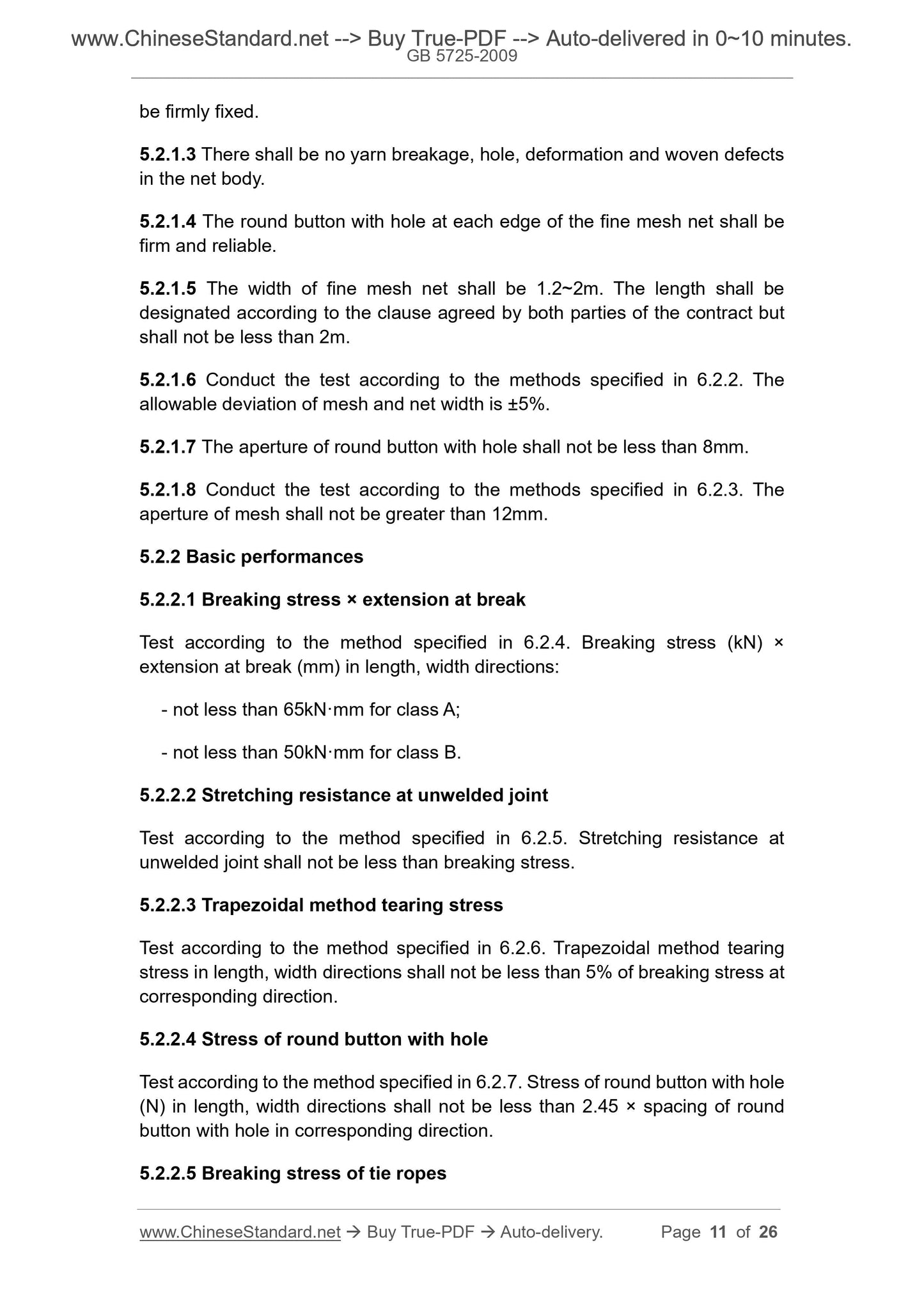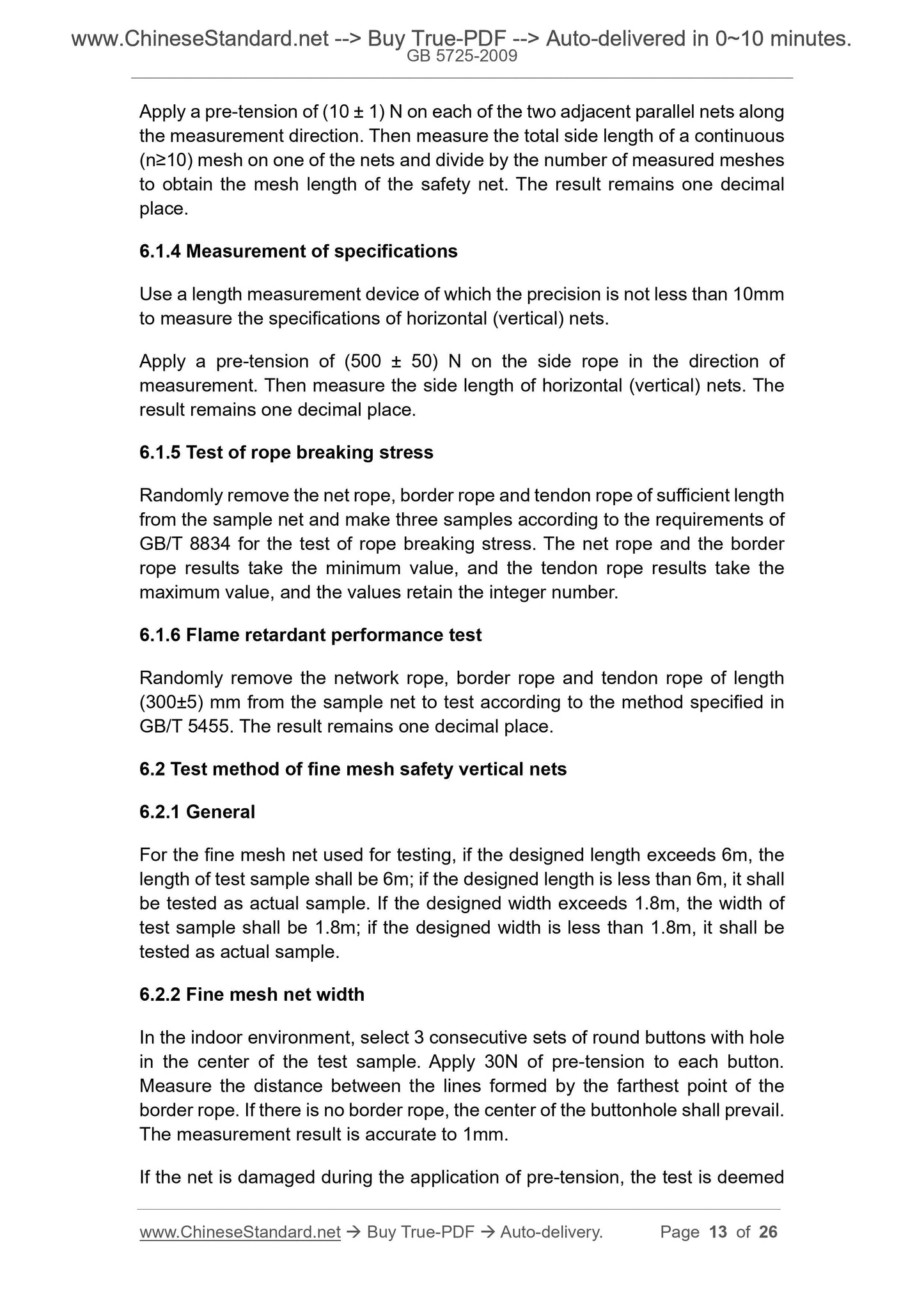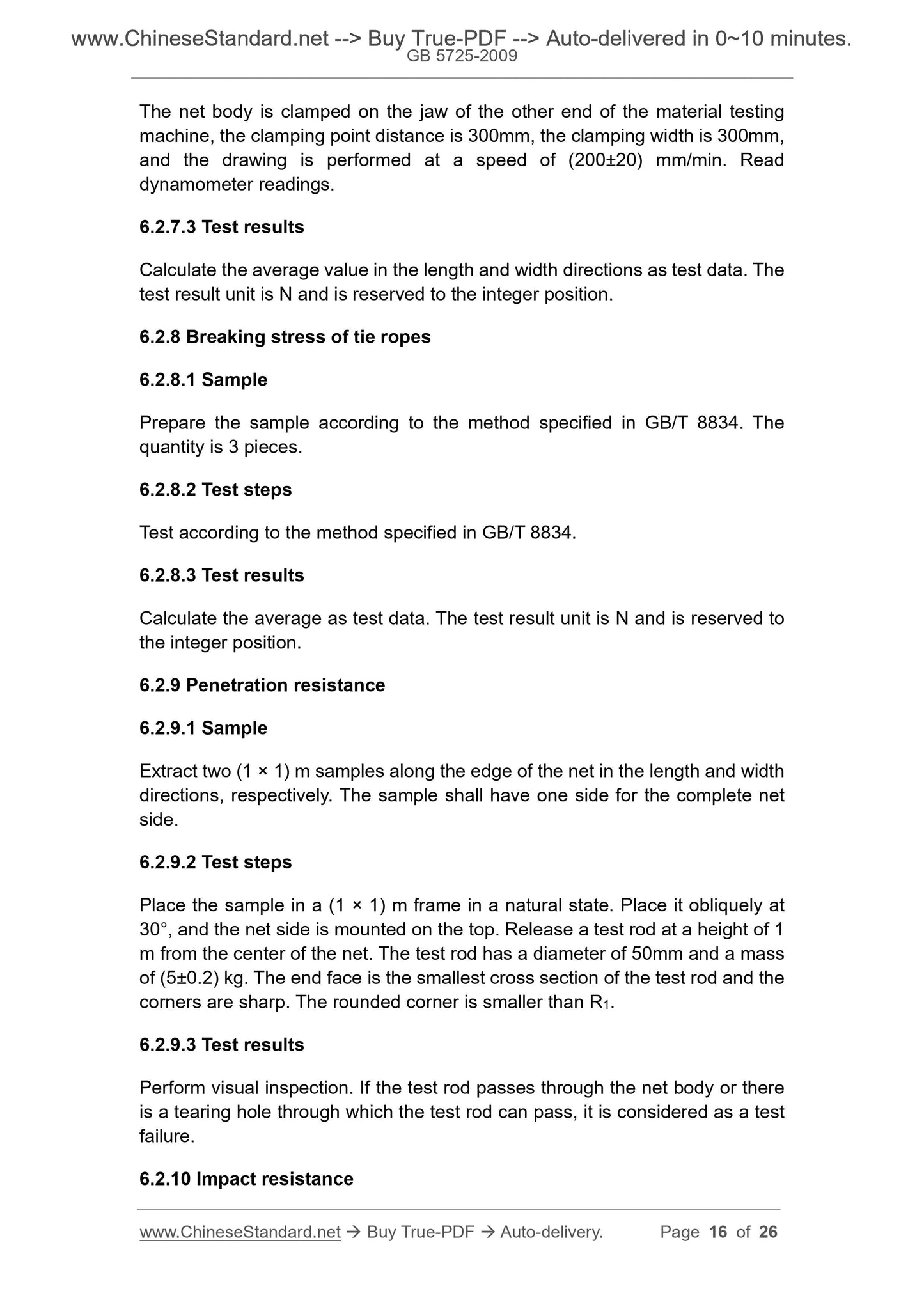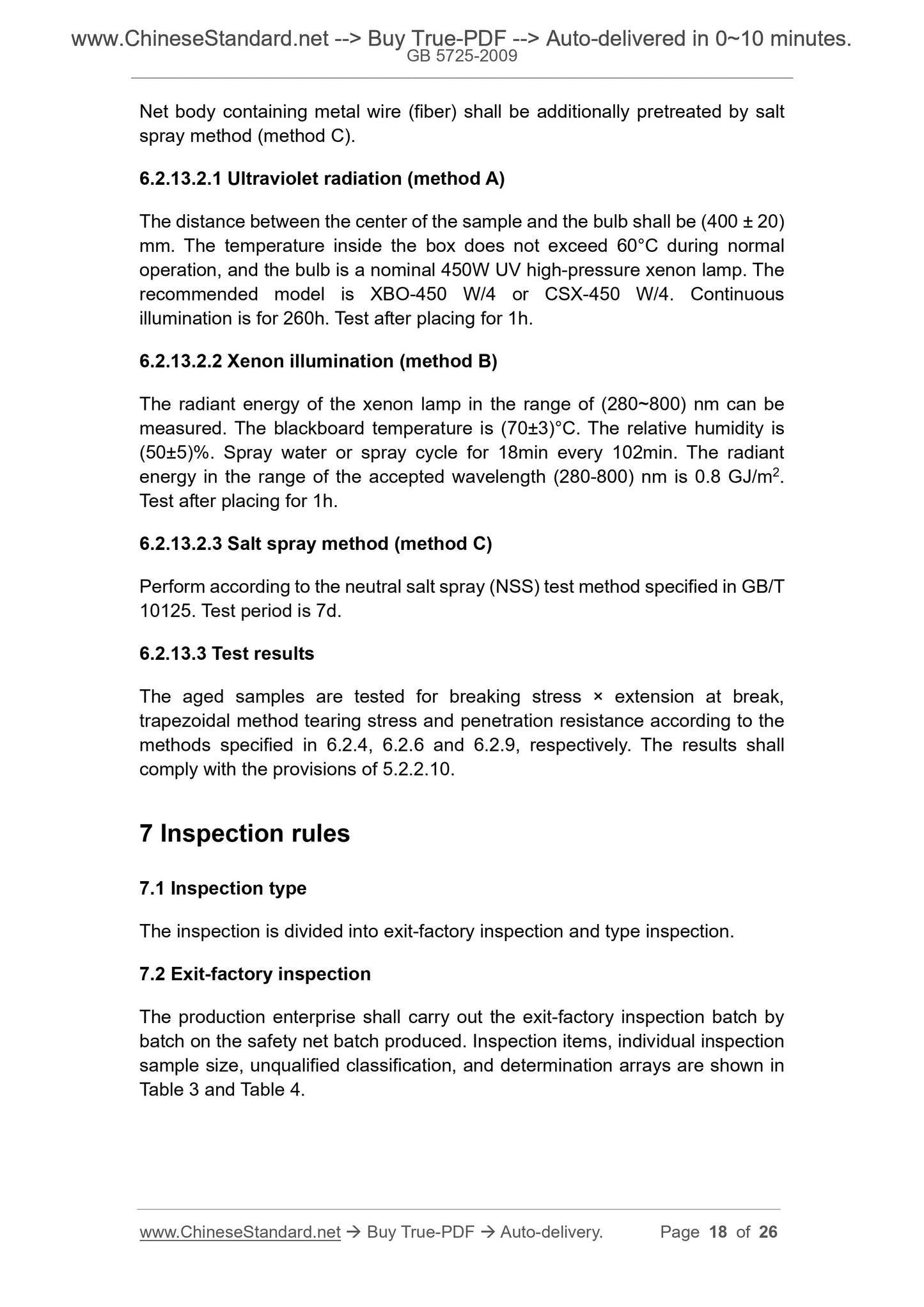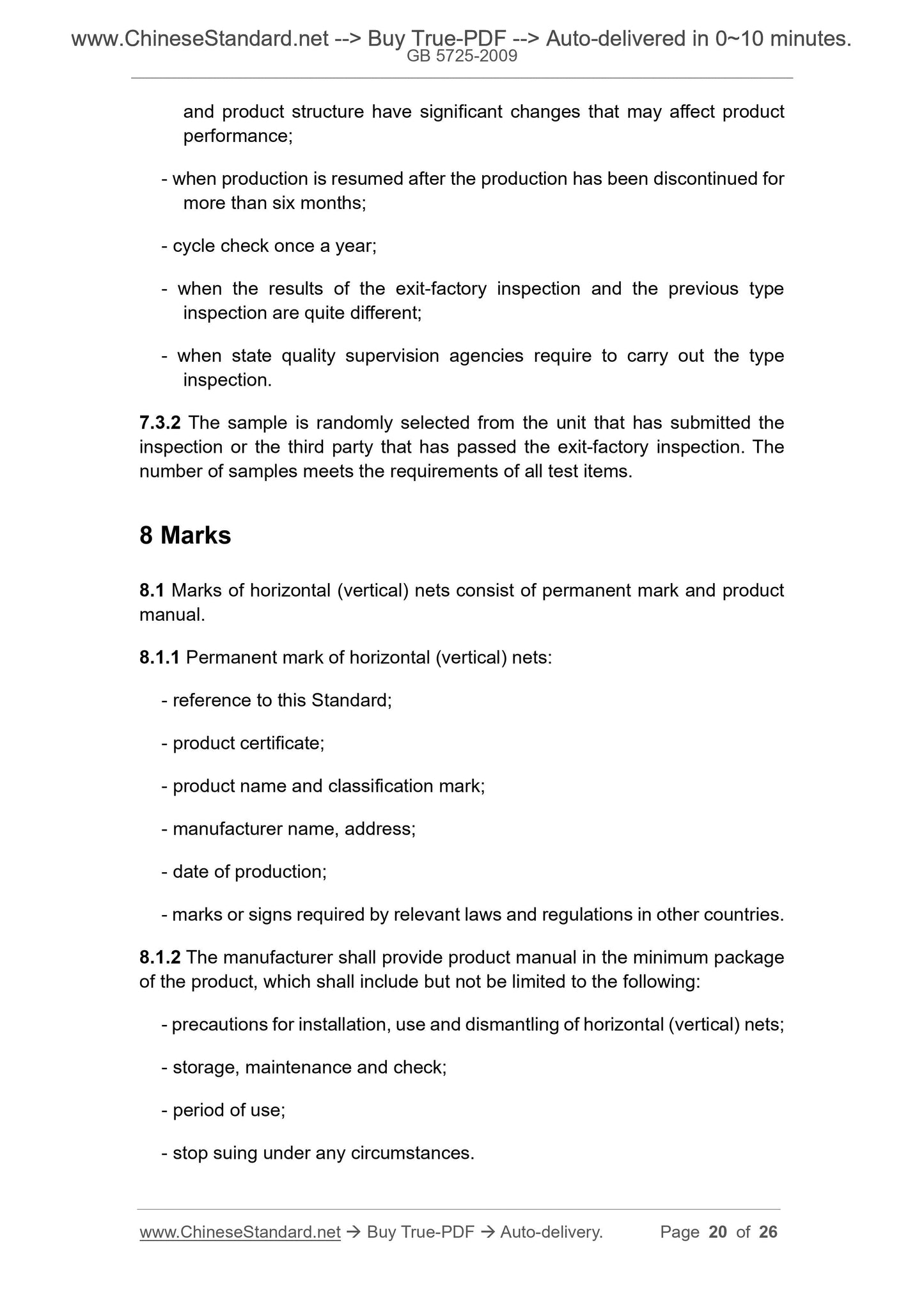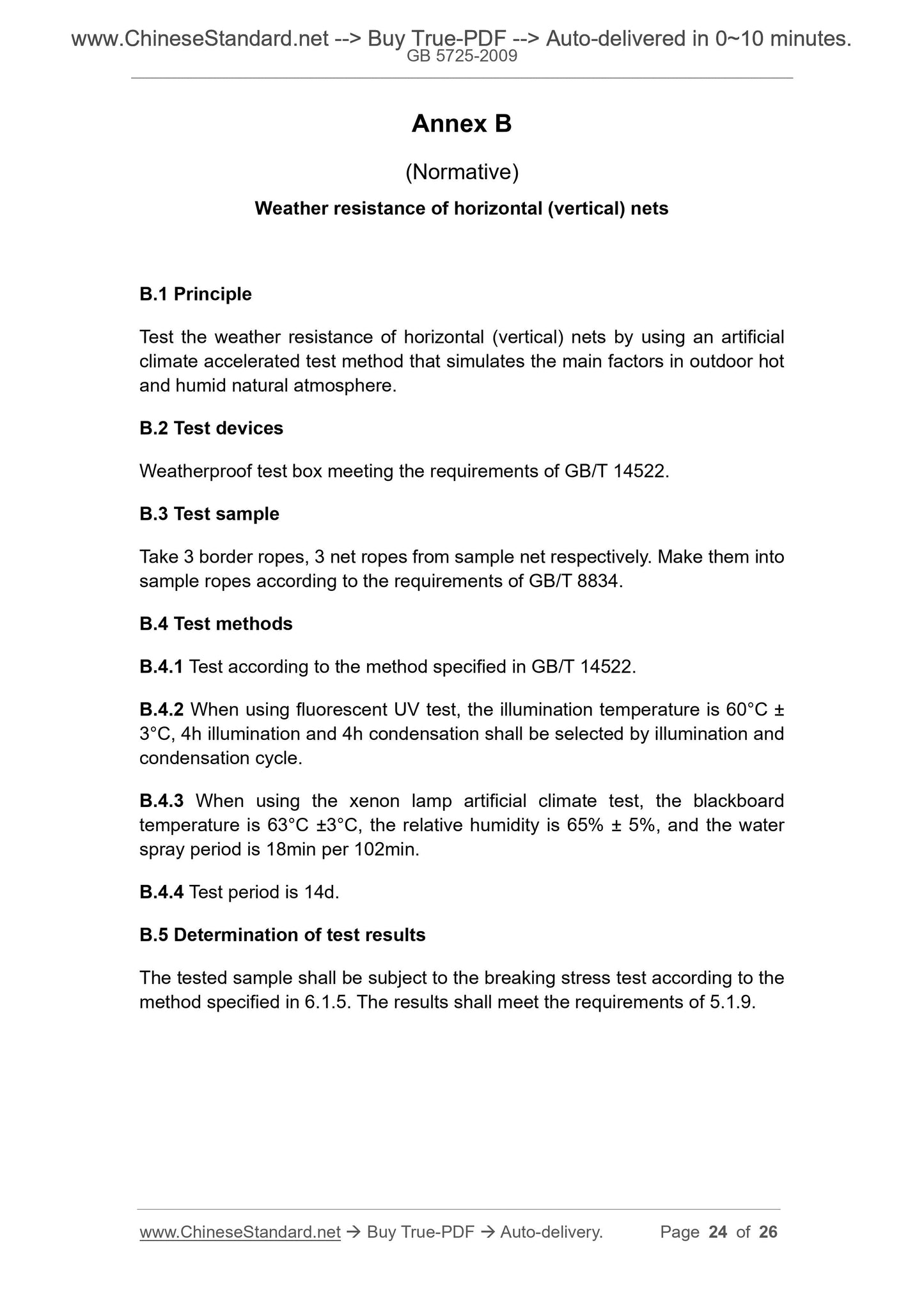1
/
su
10
PayPal, credit cards. Download editable-PDF & invoice in 1 second!
GB 5725-2009 English PDF (GB5725-2009)
GB 5725-2009 English PDF (GB5725-2009)
Prezzo di listino
$115.00 USD
Prezzo di listino
Prezzo scontato
$115.00 USD
Prezzo unitario
/
per
Spese di spedizione calcolate al check-out.
Impossibile caricare la disponibilità di ritiro
Delivery: 3 seconds. Download true-PDF + Invoice.
Get QUOTATION in 1-minute: Click GB 5725-2009
Historical versions: GB 5725-2009
Preview True-PDF (Reload/Scroll if blank)
GB 5725-2009: Safety nets
GB 5725-2009
GB
NATIONAL STANDARD OF THE
PEOPLE’S REPUBLIC OF CHINA
ICS 13.100
C 73
Replacing GB 5725-1997, GB 16909-1997
Safety nets
ISSUED ON. APRIL 01, 2009
IMPLEMENTED ON. DECEMBER 01, 2009
Issued by. General Administration of Quality Supervision, Inspection and
Quarantine;
Standardization Administration of the People's Republic of
China.
Table of Contents
Foreword ... 3
1 Scope ... 5
2 Normative references ... 5
3 Terms and definitions ... 5
4 Classification labels ... 8
5 Technical requirements ... 8
6 Test methods ... 12
7 Inspection rules ... 18
8 Marks ... 20
Annex A (Normative) Impact resistance test of safety nets ... 22
Annex B (Normative) Weather resistance of horizontal (vertical) nets ... 24
Annex C (Informative) General requirements for packaging, transport, storage
... 25
Bibliography ... 26
Safety nets
1 Scope
This Standard specifies the classification labels, technical requirements, test
methods, inspection rules and marks.
This Standard is applicable to safety nets used to prevent people or objects
from falling at work heights in buildings.
2 Normative references
The provisions in following documents become the provisions of this Standard
through reference in this Standard. For dated references, the subsequent
amendments (excluding corrigendum) or revisions do not apply to this Standard,
however, parties who reach an agreement based on this Standard are
encouraged to study if the latest versions of these documents are applicable.
For undated references, the latest edition of the referenced document applies.
GB/T 5455, Textiles - Burning behavior - Determination of damaged length,
after-glow time and after-flame time of vertically oriented specimens
GB/T 8834, Fiber ropes - Determination of certain physical and mechanical
properties
GB/T 10125, Corrosion tests in artificial atmospheres - Salt spray tests
GB/T 12903, Personal protective equipment terminology
GB/T 14522, Artificial weathering test method for plastics, coating and rubber
materials used for machinery industrial products - Fluorescent UV lamps
3 Terms and definitions
For the purposes of this document, the terms and definitions defined in GB/T
12903 as well as the followings apply.
3.1 safety nets
a net used to prevent people and objects from falling, or to avoid and mitigate
falling and physical damage
NOTE 1. A safety net is generally composed of net body, border ropes and tie ropes.
3.10 border ropes
ropes that are connected to the net along the edge of the net body
3.11 tie ropes
ropes that secure the safety net to the support
3.12 tendon ropes
ropes that are regularly worn on the mesh body to increase the strength of the
horizontal (vertical) net
3.13 mesh size
distance between two adjacent net rope knots or nodes in horizontal (vertical)
net
3.14 initial sag
sag distance of horizontally suspended safety net due to its own weight
3.15 pre-tension
load that eliminates unnatural wrinkles in the sample before testing
3.16 breaking stress
maximum tensile force measured when the mesh sample is stretched to break
NOTE. The unit of breaking stress is Newton (N) or Kilonewton (kN).
3.17 extension at break
elongation of the sample when it reaches the breaking stress
NOTE. The unit for extension at break is millimeter (mm).
3.18 stretching resistance at unwelded joint
maximum force measured when a joint is torn, when a sample is allied with
pulling force, under the specified test conditions
NOTE. The unit for stretching resistance at joint is Newton (N) or Kilonewton (kN).
3.19 trapezoidal method tearing stress
maximum tensile force measured when a trapezoidal sample is torn when the
sample is stretched
be firmly fixed.
5.2.1.3 There shall be no yarn breakage, hole, deformation and woven defects
in the net body.
5.2.1.4 The round button with hole at each edge of the fine mesh net shall be
firm and reliable.
5.2.1.5 The width of fine mesh net shall be 1.2~2m. The length shall be
designated according to the clause agreed by both parties of the contract but
shall not be less than 2m.
5.2.1.6 Conduct the test according to the methods specified in 6.2.2. The
allowable deviation of mesh and net width is ±5%.
5.2.1.7 The aperture of round button with hole shall not be less than 8mm.
5.2.1.8 Conduct the test according to the methods specified in 6.2.3. The
aperture of mesh shall not be greater than 12mm.
5.2.2 Basic performances
5.2.2.1 Breaking stress × extension at break
Test according to the method specified in 6.2.4. Breaking stress (kN) ×
extension at break (mm) in length, width directions.
- not less than 65kN·mm for class A;
- not less than 50kN·mm for class B.
5.2.2.2 Stretching resistance at unwelded joint
Test according to the method specified in 6.2.5. Stretching resistance at
unwelded joint shall not be less than breaking stress.
5.2.2.3 Trapezoidal method tearing stress
Test according to the method specified in 6.2.6. Trapezoidal method tearing
stress in length, width directions shall not be less than 5% of breaking stress at
corresponding direction.
5.2.2.4 Stress of round button with hole
Test according to the method specified in 6.2.7. Stress of round button with hole
(N) in length, width directions shall not be less than 2.45 × spacing of round
button with hole in corresponding direction.
5.2.2.5 Breaking stress of tie ropes
Apply a pre-tension of (10 ± 1) N on each of the two adjacent parallel nets along
the measurement direction. Then measure the total side length of a continuous
(n≥10) mesh on one of the nets and divide by the number of measured meshes
to obtain the mesh length of the safety net. The result remains one decimal
place.
6.1.4 Measurement of specifications
Use a length measurement device of which the precision is not less than 10mm
to measure the specifications of horizontal (vertical) nets.
Apply a pre-tension of (500 ± 50) N on the side rope in the direction of
measurement. Then measure the side length of horizontal (vertical) nets. The
result remains one decimal place.
6.1.5 Test of rope breaking stress
Randomly remove the net rope, border rope and tendon rope of sufficient length
from the sample net and make three samples according to the requirements of
GB/T 8834 for the test of rope breaking stress. The net rope and the border
rope results take the minimum value, and the tendon rope results take the
maximum value, and the values retain the integer number.
6.1.6 Flame retardant performance test
Randomly remove the network rope, border rope and tendon rope of length
(300±5) mm from the sample net to test according to the method specified in
GB/T 5455. The result remains one decimal place.
6.2 Test method of fine mesh safety vertical nets
6.2.1 General
For the fine mesh net used for testing, if the designed length exceeds 6m, the
length of test sample shall be 6m; if the designed length is less than 6m, it shall
be tested as actual sample. If the designed width exceeds 1.8m, the width of
test sample shall be 1.8m; if the designed width is less than 1.8m, it shall be
tested as actual sample.
6.2.2 Fine mesh net width
In the indoor environment, select 3 consecutive sets of round buttons with hole
in the center of the test sample. Apply 30N of pre-tension to each button.
Measure the distance between the lines formed by t...
Get QUOTATION in 1-minute: Click GB 5725-2009
Historical versions: GB 5725-2009
Preview True-PDF (Reload/Scroll if blank)
GB 5725-2009: Safety nets
GB 5725-2009
GB
NATIONAL STANDARD OF THE
PEOPLE’S REPUBLIC OF CHINA
ICS 13.100
C 73
Replacing GB 5725-1997, GB 16909-1997
Safety nets
ISSUED ON. APRIL 01, 2009
IMPLEMENTED ON. DECEMBER 01, 2009
Issued by. General Administration of Quality Supervision, Inspection and
Quarantine;
Standardization Administration of the People's Republic of
China.
Table of Contents
Foreword ... 3
1 Scope ... 5
2 Normative references ... 5
3 Terms and definitions ... 5
4 Classification labels ... 8
5 Technical requirements ... 8
6 Test methods ... 12
7 Inspection rules ... 18
8 Marks ... 20
Annex A (Normative) Impact resistance test of safety nets ... 22
Annex B (Normative) Weather resistance of horizontal (vertical) nets ... 24
Annex C (Informative) General requirements for packaging, transport, storage
... 25
Bibliography ... 26
Safety nets
1 Scope
This Standard specifies the classification labels, technical requirements, test
methods, inspection rules and marks.
This Standard is applicable to safety nets used to prevent people or objects
from falling at work heights in buildings.
2 Normative references
The provisions in following documents become the provisions of this Standard
through reference in this Standard. For dated references, the subsequent
amendments (excluding corrigendum) or revisions do not apply to this Standard,
however, parties who reach an agreement based on this Standard are
encouraged to study if the latest versions of these documents are applicable.
For undated references, the latest edition of the referenced document applies.
GB/T 5455, Textiles - Burning behavior - Determination of damaged length,
after-glow time and after-flame time of vertically oriented specimens
GB/T 8834, Fiber ropes - Determination of certain physical and mechanical
properties
GB/T 10125, Corrosion tests in artificial atmospheres - Salt spray tests
GB/T 12903, Personal protective equipment terminology
GB/T 14522, Artificial weathering test method for plastics, coating and rubber
materials used for machinery industrial products - Fluorescent UV lamps
3 Terms and definitions
For the purposes of this document, the terms and definitions defined in GB/T
12903 as well as the followings apply.
3.1 safety nets
a net used to prevent people and objects from falling, or to avoid and mitigate
falling and physical damage
NOTE 1. A safety net is generally composed of net body, border ropes and tie ropes.
3.10 border ropes
ropes that are connected to the net along the edge of the net body
3.11 tie ropes
ropes that secure the safety net to the support
3.12 tendon ropes
ropes that are regularly worn on the mesh body to increase the strength of the
horizontal (vertical) net
3.13 mesh size
distance between two adjacent net rope knots or nodes in horizontal (vertical)
net
3.14 initial sag
sag distance of horizontally suspended safety net due to its own weight
3.15 pre-tension
load that eliminates unnatural wrinkles in the sample before testing
3.16 breaking stress
maximum tensile force measured when the mesh sample is stretched to break
NOTE. The unit of breaking stress is Newton (N) or Kilonewton (kN).
3.17 extension at break
elongation of the sample when it reaches the breaking stress
NOTE. The unit for extension at break is millimeter (mm).
3.18 stretching resistance at unwelded joint
maximum force measured when a joint is torn, when a sample is allied with
pulling force, under the specified test conditions
NOTE. The unit for stretching resistance at joint is Newton (N) or Kilonewton (kN).
3.19 trapezoidal method tearing stress
maximum tensile force measured when a trapezoidal sample is torn when the
sample is stretched
be firmly fixed.
5.2.1.3 There shall be no yarn breakage, hole, deformation and woven defects
in the net body.
5.2.1.4 The round button with hole at each edge of the fine mesh net shall be
firm and reliable.
5.2.1.5 The width of fine mesh net shall be 1.2~2m. The length shall be
designated according to the clause agreed by both parties of the contract but
shall not be less than 2m.
5.2.1.6 Conduct the test according to the methods specified in 6.2.2. The
allowable deviation of mesh and net width is ±5%.
5.2.1.7 The aperture of round button with hole shall not be less than 8mm.
5.2.1.8 Conduct the test according to the methods specified in 6.2.3. The
aperture of mesh shall not be greater than 12mm.
5.2.2 Basic performances
5.2.2.1 Breaking stress × extension at break
Test according to the method specified in 6.2.4. Breaking stress (kN) ×
extension at break (mm) in length, width directions.
- not less than 65kN·mm for class A;
- not less than 50kN·mm for class B.
5.2.2.2 Stretching resistance at unwelded joint
Test according to the method specified in 6.2.5. Stretching resistance at
unwelded joint shall not be less than breaking stress.
5.2.2.3 Trapezoidal method tearing stress
Test according to the method specified in 6.2.6. Trapezoidal method tearing
stress in length, width directions shall not be less than 5% of breaking stress at
corresponding direction.
5.2.2.4 Stress of round button with hole
Test according to the method specified in 6.2.7. Stress of round button with hole
(N) in length, width directions shall not be less than 2.45 × spacing of round
button with hole in corresponding direction.
5.2.2.5 Breaking stress of tie ropes
Apply a pre-tension of (10 ± 1) N on each of the two adjacent parallel nets along
the measurement direction. Then measure the total side length of a continuous
(n≥10) mesh on one of the nets and divide by the number of measured meshes
to obtain the mesh length of the safety net. The result remains one decimal
place.
6.1.4 Measurement of specifications
Use a length measurement device of which the precision is not less than 10mm
to measure the specifications of horizontal (vertical) nets.
Apply a pre-tension of (500 ± 50) N on the side rope in the direction of
measurement. Then measure the side length of horizontal (vertical) nets. The
result remains one decimal place.
6.1.5 Test of rope breaking stress
Randomly remove the net rope, border rope and tendon rope of sufficient length
from the sample net and make three samples according to the requirements of
GB/T 8834 for the test of rope breaking stress. The net rope and the border
rope results take the minimum value, and the tendon rope results take the
maximum value, and the values retain the integer number.
6.1.6 Flame retardant performance test
Randomly remove the network rope, border rope and tendon rope of length
(300±5) mm from the sample net to test according to the method specified in
GB/T 5455. The result remains one decimal place.
6.2 Test method of fine mesh safety vertical nets
6.2.1 General
For the fine mesh net used for testing, if the designed length exceeds 6m, the
length of test sample shall be 6m; if the designed length is less than 6m, it shall
be tested as actual sample. If the designed width exceeds 1.8m, the width of
test sample shall be 1.8m; if the designed width is less than 1.8m, it shall be
tested as actual sample.
6.2.2 Fine mesh net width
In the indoor environment, select 3 consecutive sets of round buttons with hole
in the center of the test sample. Apply 30N of pre-tension to each button.
Measure the distance between the lines formed by t...
Share
